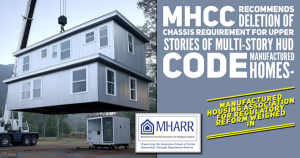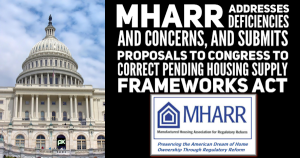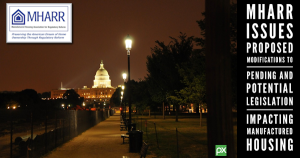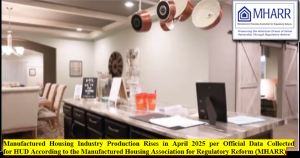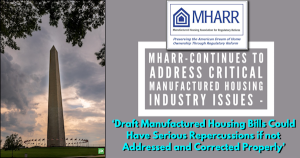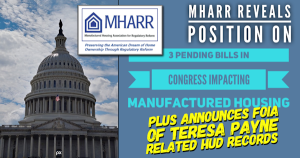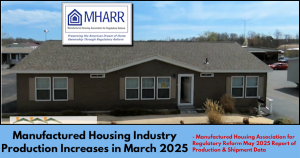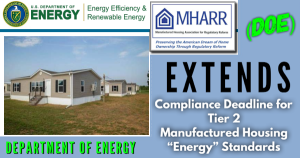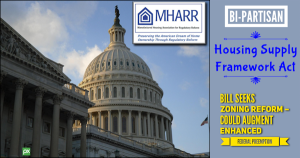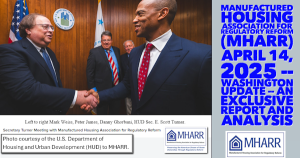MHARR March 11, 2024 Washington Update — An Exclusive Report and Analysis

Attached please find your copy of the March 11, 2024 “MHARR WASHINGTON UPDATE” an exclusive report and analysis addressing:
REPORT AND ANALYSIS
MARCH 11, 2024
IN THIS REPORT:
- HUD SECRETARY ANNOUNCES RETIREMENT
- AEI ANALYSIS VINDICATES MHARR INDUSTRY PRIORITIES
- “AFFORDABLE” IS THE CORRECT TERM FOR HUD CODE MH
HUD SECRETARY MARCIA FUDGE ANNOUNCES RETIREMENT/RESIGNATION
In an unexpected announcement issued on March 11, 2024, HUD Secretary Marcia Fudge has announced her retirement/resignation as Secretary of the U.S. Department of Housing and Urban Development (HUD), effective March 22, 2024 (copy attached). The Secretary’s announcement does not state any cause or reason for her early departure, nearly a year before the conclusion of President Biden’s current term of office.
While Secretary Fudge, during her tenure, made a number of positive statements regarding affordable, mainstream manufactured housing and the role that it could play in addressing the nation’s affordable housing crisis, concrete action on a number of the key roadblocks suppressing the availability and utilization of HUD Code homes, including, most particularly, the abuse of zoning and land use laws to discriminatorily exclude manufactured housing from communities and areas around the country, has not been forthcoming.
This is a rapidly-developing situation. MHARR will closely monitor developments relating to the selection of a new – or acting – Secretary, and will provide further updates as warranted.
AEI ANALYSIS OF BIDEN HOUSING POLICIES VINDICATES MHARR PRIORITIES
On March 1, 2024, MHARR published a talking points paper explaining and highlighting the three main bottlenecks that are suppressing the “production, marketing and sales of affordable, mainstream manufactured homes.” This paper added additional context to MHARR’s July 2022 White Paper regarding the “Exploitation of Federal Housing Finance and Mortgage Assistance Programs and Potential Solutions” – addressing the under-reported reality that federal funding for “housing” and “housing finance” programs rarely if ever “reaches the ground” in large volume for mainstream, affordable manufactured housing and manufactured housing consumers.
The three main bottlenecks suppressing the HUD Code industry – currently and historically – for at least two decades (and in some cases longer), are discriminatory and exclusionary zoning, limited availability of market-competitive, government-backed consumer financing and, more recently, the looming threat of draconian, discriminatory U.S. Department of Energy (DOE) “energy conservation” standards for manufactured homes. All of these factors have – and unless remedied, will continue to – needlessly limit the availability and utilization of affordable, mainstream manufactured homes in many areas of the country, notwithstanding record-breaking demand for affordable housing and home ownership.
And now, a widely-respected policy organization in Washington, D.C., the Housing Center of the American Enterprise Institute (AEI), led by Edward Pinto, has released an analysis of the housing policy and related spending initiatives announced by President Biden during his recent State of the Union speech, which in substantial part corresponds with and supports one of the principal assertions of MHARR’s summary and earlier White Paper – specifically, that needlessly restrictive zoning and land use laws have been and are suppressing the supply of affordable starter homes (which category necessarily includes affordable, mainstream manufactured homes) (see copy attached). In part, that analysis states:
“There is a growing consensus that the solution to making housing more affordable lies in adding more housing supply, not in easy credit and market distorting subsidies. The solution is for states and localities to free the market from unduly restrictive zoning and land use restrictions that constrain supply and drive up home prices.”
(Emphasis added).
In substantial part, then, federal housing (i.e., spending) programs do little to actually benefit either manufactured housing consumers or the manufactured housing industry because – despite the fact that HUD Code homes are the nation’s premier source of inherently affordable home ownership – those same homes (and their residents) are discriminatorily excluded from far too many areas of the country. Therefore, rather than trumpet spending that will not “reach the ground” for the HUD Code market, HUD should and must address the root cause(es) of the problem, including discriminatory zoning and land use laws. HUD currently has – and has had – the legal means to remove these baseless restrictions, in the form of the enhanced federal preemption of the Manufactured Housing Improvement Act of 2000 (2000 Reform Law), but has failed and refused to take the necessary action. This must change for the industry to fulfill the affordable housing role and mission that Congress foresaw for it in the 2000 Reform Law and it must be the goal, objective and mission of the industry’s national representatives – and most especially the national representative of its post-production sector – to advance zoning equity as well as fully competitive and available consumer financing for HUD Code homes and HUD Code consumers.
MANUFACTURED HOUSING IS AFFORDABLE HOUSING
As MHARR stressed in its November 2023 Issues and Perspectives article, “What’s in a Name? – Everything,” both the name and description(s) of the homes that industry members produce, sell, market, finance and supply are important. Fundamental industry messaging to both public (i.e., government) and private entities with an interest in manufactured housing, is critical to the availability, utilization and, even more importantly, the wider acceptance of manufactured housing as a crucial source of affordable housing and home ownership. And it is that single word – “affordable” – that is of overriding and overwhelming importance in this context. That is why MHARR, more than two decades ago, led the way in advancing not only the inclusion, but the emphasis of that term in the Manufactured Housing Improvement Act of 2000.
That is why it is both troubling and puzzling that some within the industry are apparently working to move away from the industry’s long-time emphasis on affordability and manufactured homes as a source of inherently affordable home ownership, and are instead describing HUD Code homes as “attainable.” This effort is curious not only because concept of “affordability” is specifically ingrained in federal law, but also because the language and concept of affordability is more widely accepted and used today than ever before. Indeed, the terms “affordable” and “affordability” have been used not only by HUD Secretary Marcia Fudge, but by President Biden himself, as recently as his State of the Union address, as shown in AEI’s attached analysis. Why then, would anyone, let alone an advocate for manufactured housing, sacrifice the use of that positive and important descriptive term?
The word “affordable” has a specific context and meaning not only for government entities, but, more importantly, for consumers who need “affordable” homes. The term “attainable,” by contrast relates to no specific economic metric and has no specific meaning for consumers and, most particularly, consumers at lower or moderate-income levels. Americans need affordable housing and home ownership. That is what they understand and that is what their representatives in government understand. And decades later, it is the term that has widely taken root, as demonstrated by no less than the President himself.
Now is not the time to abandon the concept and language of affordability in favor of a term like “attainable,” which has no legal/legislative history and no specific economic meaning or corresponding metric. The words of the 2000 Reform Law, including its reference to the “affordability” of manufactured housing, were originally coined by MHARR in the 1990s, during the 2000 Reform Law legislative process, and were carefully chosen and included in its final language. Further, they reflect the reality that among the different segments of the housing industry, HUD Code homes are not only relatively affordable, but, in fact, the most affordable. That term should not be abandoned or sacrificed on a whim, and the impulse among some (who either have not learned or do not fully appreciate the industry’s rich evolutionary history) to do so, must be rejected.
Attached please find your copy of the March 11, 2024 “MHARR WASHINGTON UPDATE” an exclusive report and analysis addressing:
REPORT AND ANALYSIS
MARCH 11, 2024
IN THIS REPORT:
- HUD SECRETARY ANNOUNCES RETIREMENT
- AEI ANALYSIS VINDICATES MHARR INDUSTRY PRIORITIES
- “AFFORDABLE” IS THE CORRECT TERM FOR HUD CODE MH
HUD SECRETARY MARCIA FUDGE ANNOUNCES RETIREMENT/RESIGNATION
In an unexpected announcement issued on March 11, 2024, HUD Secretary Marcia Fudge has announced her retirement/resignation as Secretary of the U.S. Department of Housing and Urban Development (HUD), effective March 22, 2024 (copy attached). The Secretary’s announcement does not state any cause or reason for her early departure, nearly a year before the conclusion of President Biden’s current term of office.
While Secretary Fudge, during her tenure, made a number of positive statements regarding affordable, mainstream manufactured housing and the role that it could play in addressing the nation’s affordable housing crisis, concrete action on a number of the key roadblocks suppressing the availability and utilization of HUD Code homes, including, most particularly, the abuse of zoning and land use laws to discriminatorily exclude manufactured housing from communities and areas around the country, has not been forthcoming.
This is a rapidly-developing situation. MHARR will closely monitor developments relating to the selection of a new – or acting – Secretary, and will provide further updates as warranted.
AEI ANALYSIS OF BIDEN HOUSING POLICIES VINDICATES MHARR PRIORITIES
On March 1, 2024, MHARR published a talking points paper explaining and highlighting the three main bottlenecks that are suppressing the “production, marketing and sales of affordable, mainstream manufactured homes.” This paper added additional context to MHARR’s July 2022 White Paper regarding the “Exploitation of Federal Housing Finance and Mortgage Assistance Programs and Potential Solutions” – addressing the under-reported reality that federal funding for “housing” and “housing finance” programs rarely if ever “reaches the ground” in large volume for mainstream, affordable manufactured housing and manufactured housing consumers.
The three main bottlenecks suppressing the HUD Code industry – currently and historically – for at least two decades (and in some cases longer), are discriminatory and exclusionary zoning, limited availability of market-competitive, government-backed consumer financing and, more recently, the looming threat of draconian, discriminatory U.S. Department of Energy (DOE) “energy conservation” standards for manufactured homes. All of these factors have – and unless remedied, will continue to – needlessly limit the availability and utilization of affordable, mainstream manufactured homes in many areas of the country, notwithstanding record-breaking demand for affordable housing and home ownership.
And now, a widely-respected policy organization in Washington, D.C., the Housing Center of the American Enterprise Institute (AEI), led by Edward Pinto, has released an analysis of the housing policy and related spending initiatives announced by President Biden during his recent State of the Union speech, which in substantial part corresponds with and supports one of the principal assertions of MHARR’s summary and earlier White Paper – specifically, that needlessly restrictive zoning and land use laws have been and are suppressing the supply of affordable starter homes (which category necessarily includes affordable, mainstream manufactured homes) (see copy attached). In part, that analysis states:
“There is a growing consensus that the solution to making housing more affordable lies in adding more housing supply, not in easy credit and market distorting subsidies. The solution is for states and localities to free the market from unduly restrictive zoning and land use restrictions that constrain supply and drive up home prices.”
(Emphasis added).
In substantial part, then, federal housing (i.e., spending) programs do little to actually benefit either manufactured housing consumers or the manufactured housing industry because – despite the fact that HUD Code homes are the nation’s premier source of inherently affordable home ownership – those same homes (and their residents) are discriminatorily excluded from far too many areas of the country. Therefore, rather than trumpet spending that will not “reach the ground” for the HUD Code market, HUD should and must address the root cause(es) of the problem, including discriminatory zoning and land use laws. HUD currently has – and has had – the legal means to remove these baseless restrictions, in the form of the enhanced federal preemption of the Manufactured Housing Improvement Act of 2000 (2000 Reform Law), but has failed and refused to take the necessary action. This must change for the industry to fulfill the affordable housing role and mission that Congress foresaw for it in the 2000 Reform Law and it must be the goal, objective and mission of the industry’s national representatives – and most especially the national representative of its post-production sector – to advance zoning equity as well as fully competitive and available consumer financing for HUD Code homes and HUD Code consumers.
MANUFACTURED HOUSING IS AFFORDABLE HOUSING
As MHARR stressed in its November 2023 Issues and Perspectives article, “What’s in a Name? – Everything,” both the name and description(s) of the homes that industry members produce, sell, market, finance and supply are important. Fundamental industry messaging to both public (i.e., government) and private entities with an interest in manufactured housing, is critical to the availability, utilization and, even more importantly, the wider acceptance of manufactured housing as a crucial source of affordable housing and home ownership. And it is that single word – “affordable” – that is of overriding and overwhelming importance in this context. That is why MHARR, more than two decades ago, led the way in advancing not only the inclusion, but the emphasis of that term in the Manufactured Housing Improvement Act of 2000.
That is why it is both troubling and puzzling that some within the industry are apparently working to move away from the industry’s long-time emphasis on affordability and manufactured homes as a source of inherently affordable home ownership, and are instead describing HUD Code homes as “attainable.” This effort is curious not only because concept of “affordability” is specifically ingrained in federal law, but also because the language and concept of affordability is more widely accepted and used today than ever before. Indeed, the terms “affordable” and “affordability” have been used not only by HUD Secretary Marcia Fudge, but by President Biden himself, as recently as his State of the Union address, as shown in AEI’s attached analysis. Why then, would anyone, let alone an advocate for manufactured housing, sacrifice the use of that positive and important descriptive term?
The word “affordable” has a specific context and meaning not only for government entities, but, more importantly, for consumers who need “affordable” homes. The term “attainable,” by contrast relates to no specific economic metric and has no specific meaning for consumers and, most particularly, consumers at lower or moderate-income levels. Americans need affordable housing and home ownership. That is what they understand and that is what their representatives in government understand. And decades later, it is the term that has widely taken root, as demonstrated by no less than the President himself.
Now is not the time to abandon the concept and language of affordability in favor of a term like “attainable,” which has no legal/legislative history and no specific economic meaning or corresponding metric. The words of the 2000 Reform Law, including its reference to the “affordability” of manufactured housing, were originally coined by MHARR in the 1990s, during the 2000 Reform Law legislative process, and were carefully chosen and included in its final language. Further, they reflect the reality that among the different segments of the housing industry, HUD Code homes are not only relatively affordable, but, in fact, the most affordable. That term should not be abandoned or sacrificed on a whim, and the impulse among some (who either have not learned or do not fully appreciate the industry’s rich evolutionary history) to do so, must be rejected.

